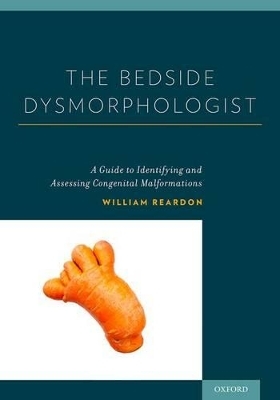
The Bedside Dysmorphologist
Oxford University Press Inc (Verlag)
978-0-19-997088-9 (ISBN)
No other book in the market sets out to assist the pediatrician and other non-geneticists in how to interpret the clinical signs in syndromology and to lead the clinician to sensible conclusions, both in terms of clinical management and in terms of initiating of appropriate investigation. The Bedside Dysmorphologist distills a lifetime of clinical experience, nuance, and variation into a manageable volume, one that will instill confidence in clinicians and guide them through this arcane area of medicine.
A career geneticist, William Reardon has authored an excess of 250 papers in research journals, multiple chapters in textbooks, and two books. Dr. Reardon is widely experienced as a Medical Expert Witness and much in demand as an examiner and educationalist, as well as in clinical practice. For further, see www.williereardon.com.
Chapter 1: The Skull ; 1.1 Plagiocephaly ; 1.2 Metopic Ridge ; 1.3 Scalp Defects ; 1.4 Macrocephaly ; 1.5 Microcephaly ; 1.6 Frontal Hairline Variants - High Hairline and Frontal Upsweep ; 1.7 Frontal Hairline Variants - Low Hairline and Widow's Peak ; 1.8 Low Posterior Hairline ; 1.9 Anencephaly ; 1.10 Abnormal Anterior Fontanelle ; Chapter 2: The Face ; 2.1 Hypertelorism ; 2.2 Hypotelorism ; 2.3 Abnormal Nasal Bridge ; 2.4 Abnormal Alae Nasi and Nasal Tip ; 2.5 Prominent Nose ; 2.6 Abnormal Nasal Columella and Nares ; 2.7 Abnormal Nasal Septum ; 2.8 Abnormal Nasal Appendages ; 2.9 Synophrys ; 2.10 Midfacial Hypoplasia ; 2.11 Micrognathia ; 2.12 Facial Asymmetry ; 2.13 Myopathic Facies ; 2.14 Abnormalities of the Philtrum ; Chapter 3: The Eye and Related Structures ; 3.1 Epicanthus ; 3.2 Deep Set Eyes ; 3.3 Almond Shaped Eye ; 3.4 Blepharophimosis ; 3.5 Palpebral Fissure Slant ; 3.6 Proptosis ; 3.7 Ptosis of the Eyelid ; 3.8 Corneal Clouding ; 3.9 Ectopic Pupil ; 3.10 Blue Sclerae ; 3.11 Iris Coloboma ; 3.12 Anophthalmia/Microphthalmia ; 3.13 Iris Variants ; 3.14 Ectropion of the Lower Eyelid ; 3.15 Eyebrow Variants ; 3.16 Eyelash Variants ; 3.17 Epibulbar Dermoid ; Chapter 4: The Ear ; 4.1 Low-Set Ears ; 4.2 Posteriorly Rotated Ears ; 4.3 Auricular Pits ; 4.4 Microtia ; 4.5 External Ear Variants ; 4.6 Ear Lobe Variants ; 4.7 External Auditory Canal Atresia or Stenosis ; 4.8 Auricular Tags ; Chapter 5: The Mouth and Oral Cavity ; 5.1 Microstomia. ; 5.2 Upper Lip Clefts ; 5.3 Lip Pits ; 5.4 Thick and Thin Upper Lips ; 5.5 Lip and Oral Mucosa Pigmentation ; 5.6 Macroglossia ; 5.7 Accessory Oral Frenula ; 5.8 Isolated Cleft Palate ; 5.9 Persistent drooling ; 5.10 Gum Hyperplasia ; Chapter 6: The Neck ; 6.1 Neck Webbing ; 6.2 Short Neck ; 6.3 Goitre ; 6.4 Neck Sinuses/Fistulae/Pits/Cysts. ; 6.5 Occipital Horns ; Chapter 7: The Chest ; 7.1 Poland Anomaly ; 7.2 Accessory Nipples ; 7.3 Athelia/Hypothelia (absent or hypoplastric nipples) ; 7.4 Gynaecomastia ; 7.5 Sloping shoulders ; 7.6 Small Thorax ; 7.7 Pectus Excavatum and Carninatum ; 7.8 Scoliosis ; Chapter 8: The Abdomen and Perineum ; 8.1 Minor Anomalies of the Umbilicus ; 8.2 Umbilical Hernia/Omphalocoele ; 8.3 Inguinal Hernia ; 8.4 Small Penis/Micropenis ; 8.5- Ambiguous Genitalia ; 8.6 Hypospadias ; 8.7 Shawl Scrotum and Peno-Scrotal Transposition. ; 8.8 Anal Atresia, Anal Stenosis and Anterior Displacement of the Anus ; 8.9 Caudal Appendage ; Chapter 9: The Hands ; 9.1 Postaxial polydactyly ; 9.2 Pre-axial polydactyly/Thumb duplication ; 9.3 Syndactyly of the Fingers ; 9.4 Clinodactyly of the Fingers ; 9.5 Arachnodactyly of the Fingers ; 9.6 Camptodactyly ; 9.7 Brachydactyly ; 9.8 Tapering Fingers ; 9.9 Puffy Fingers ; 9.10 Overlapping Fingers ; 9.11 Ectrodactyly ; 9.12 Broad Thumbs ; 9.13 Small and Hypoplastic Thumbs ; 9.14 Long and Triphalangeal Thumbs ; 9.15 Trident Hand ; 9.16 Fetal Finger Pads ; 9.17 Ulnar Ray Defects ; 9.18 Palmar Crease Patterns of Special Diagnostic Significance ; Chapter 10: The Feet ; 10.1 Preaxial Polydactyly ; 10.2 Broad Halluces ; 10.3 Post-axial Polydactyly ; 10.4 Syndactyly Toes 2/3 ; 10.5 Hypoplastic and Missing Toes ; 10.6 Longitudinal Plantar Creases ; 10.7 Foot Oedema ; 10.8 Short 4th and 5th Metatarsals ; 10.9 Plantar Fat Pads ; Chapter 11: The Limbs ; 11.1 Limb Asymmetry ; 11.2 Symmetric Short Limbs ; 11.3 Limb Reduction Defects ; 11.4 Localised Lumps on the Limb ; 11.5 Arthrogryposis Congenita ; 11.6 Joint Enlargement ; 11.7 Generalised Joint Hypermobility ; 11.8 Small or Absent Patella ; 11.9 Pseudoarthrosis ; 11.10 Madelung Deformity ; 11.11 Hairy Elbows (Hypertrichosis Cubiti) ; Chapter 12: The Nails, Hair, and Skin ; 12.1 Absent or Hypoplastic Nails. ; 12.2 "Tale of a Nail" sign ; 12.3 Longitudinal Splitting of the Nails ; 12.4 Short Nails ; 12.5 Temporal Balding ; 12.6 Sparse Hair/Alopecia ; 12.7 Poliosis ; 12.8 Cafe-au-Lait Patches ; 12.9 Acanthosis Nigricans ; 12.10 Diffuse Hypopigmented Streaky Lesions ; 12.11 Piebaldism ; 12.12 Cutis Marmorata ; 12.13 Capillary Haemangioma ; 12.14 Telangiectasia ; 12.15 Ichthyosis ; 12.16 Excess Skin ; 12.17 Lentigenes ; 12.18 Nevus Flammeus Neonatorum
| Verlagsort | New York |
|---|---|
| Sprache | englisch |
| Maße | 211 x 142 mm |
| Gewicht | 726 g |
| Themenwelt | Medizin / Pharmazie ► Medizinische Fachgebiete ► Gynäkologie / Geburtshilfe |
| Medizin / Pharmazie ► Medizinische Fachgebiete ► Pädiatrie | |
| Studium ► 2. Studienabschnitt (Klinik) ► Anamnese / Körperliche Untersuchung | |
| Studium ► 2. Studienabschnitt (Klinik) ► Humangenetik | |
| Studium ► 2. Studienabschnitt (Klinik) ► Pathologie | |
| ISBN-10 | 0-19-997088-2 / 0199970882 |
| ISBN-13 | 978-0-19-997088-9 / 9780199970889 |
| Zustand | Neuware |
| Informationen gemäß Produktsicherheitsverordnung (GPSR) | |
| Haben Sie eine Frage zum Produkt? |
aus dem Bereich


